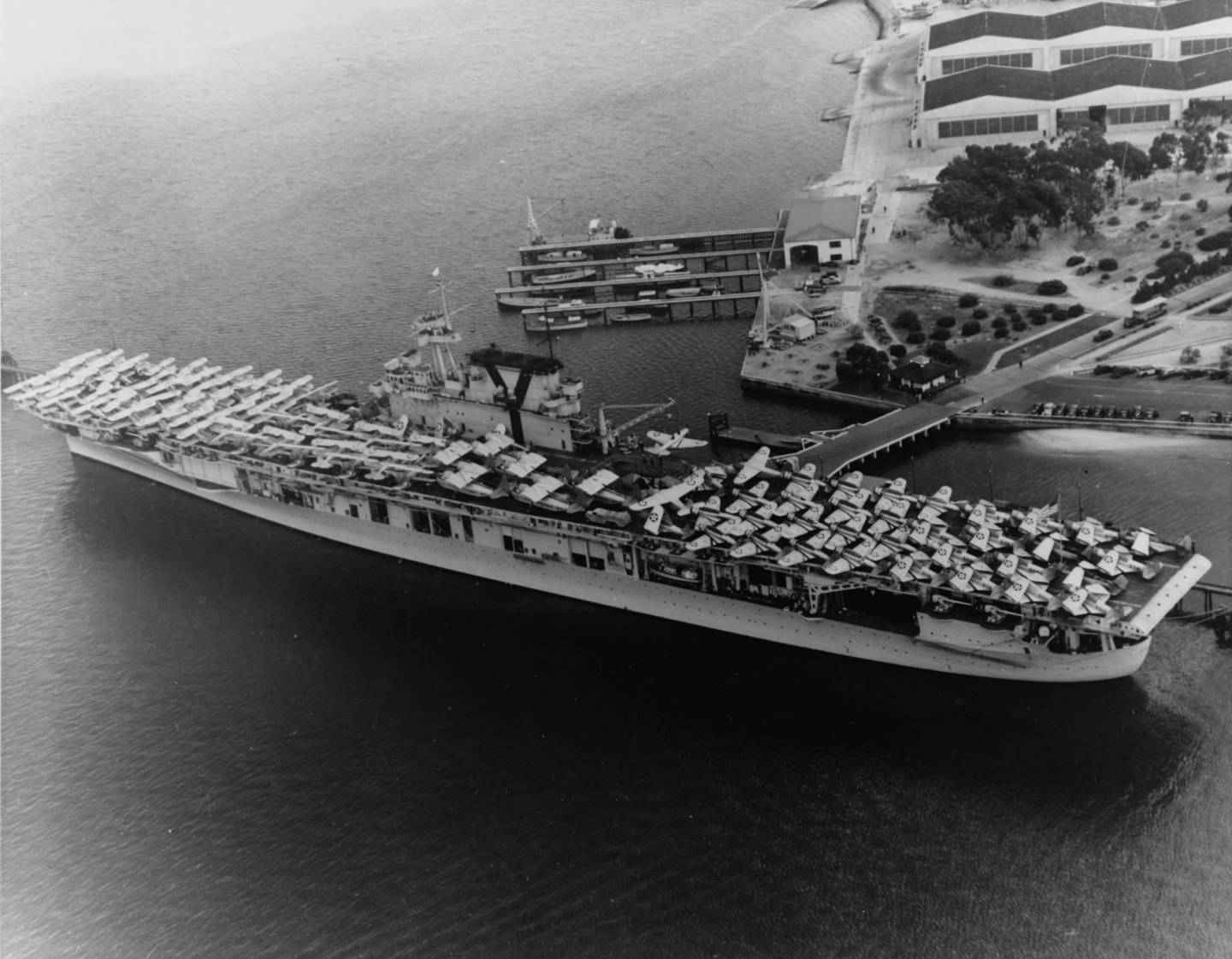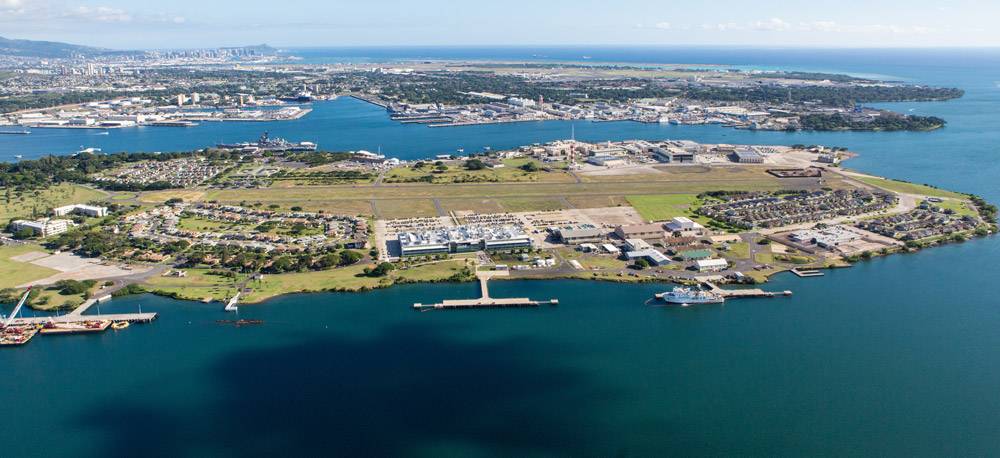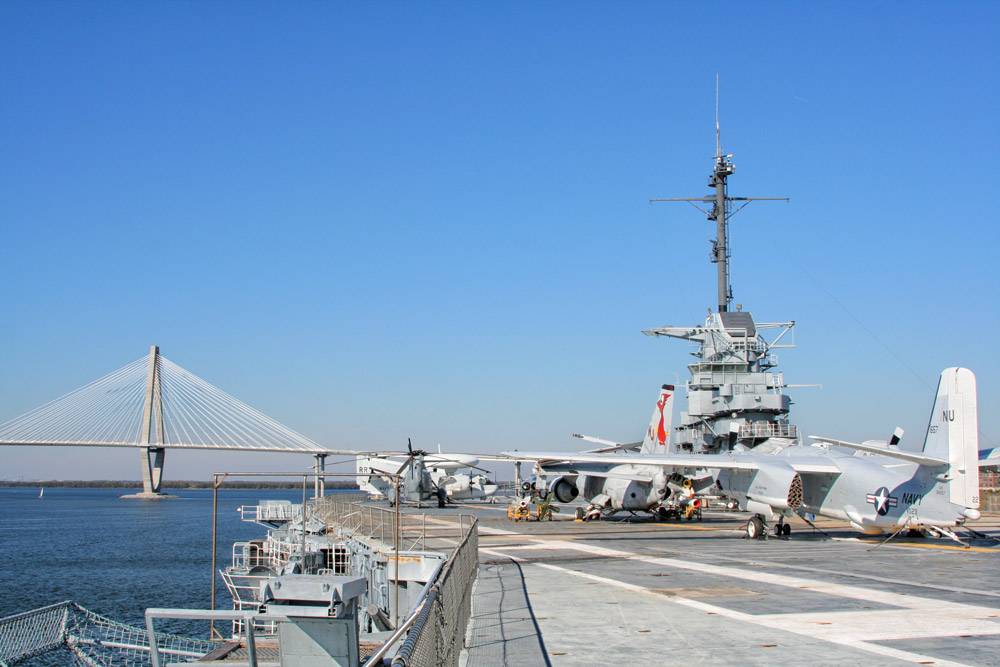One of the most predominate sites on our tour is the USS Yorktown (CV-10). The Yorktown is located at Patriot’s Point In Mt. Pleasant just over the Ravenel bridge from downtown Charleston. Patriot’s Point is a museum of several ships including a Vietnam camp replica. For anyone that likes history, ships, old things or just likes to marvel at what humans can accomplish without the use of computers this is a must see while in Charleston.
CV-10 or Carrier Vessel is an Essex-class carrier that was built in 1941 and commissioned in 1943. CV-10 was originally named Bonhomme Richard it was renamed Yorktown during construction to commemorate CV-5, also named the Yorktown. CV-5 was sunk in 1942 during the Battle of Midway.

Yorktown (CV-5) prepares to get under way from NAS San Diego (June 1940)
CV-5 Yorktown was the lead ship of the Yorktown class. She was a straight deck carrier and was designed and built in 1943 in Newport News Virginia, after lessons learned in the Lexington class converted battlecruisers. She was launched in 1936 and after many sea trials, fitting out, and war exercises Yorktown headed to the Pacific fleet in 1939.
The US enters the war after the Japanese bombed Pearl Harbor on December 7, 1941 killing over 2,400 Americans and sinking or damaging 16 ships and 250 aircraft. CV-6 was damaged during the battle of the Cora Sea and arrived back in Pearl Harbor for repairs in May. She was minimally repaired and ready to head to sea to meet up with the Pacific Fleet Northeast of Midway. During this time after attacking several Japanese ships a raid on the Yorktown insured. The Yorktown and its planes fought off much on the incoming attack but 3 planes were able to hit the Yorktown. Just hours later after they had controlled all the burning and got the boilers running again the radar picked up another attack. This time The Yorktown was not so lucky and was fatally wonded. She had lost all power and had a jammed rudder and was dead in the water with a list to the port side. The ship was abandoned and was hit again by Japanese subs during a salvage operation. By June 7,1942 the damage was to much for the Yorktown and rolled upside-down and sank.

Smoke pours from Yorktown after being hit in the boilers by Japanese dive bombers at Midway
The Yorktown CV-10 left Pearl Harbor on August 22,1943 for its first missions of the war just off Marcus Island. CV-10 also ran missions on Wake Island. Several months later it participated in it first major assault on the Gilbert Islands, Tarawa, Abemama and Makin. For the next year it participated in raids from Marianas to New Guinea and even on the main land Japan. In June it was making air strikes on Guam to prevent the Japanese from launching their planes. It then returned to Pearl Harbor for more air training operations.
In 1944 in January it left Pearl Harbor to assist in operation Flintlock, the invasion of the Marshall Islands. The York town the Lexington and the Cowpens began air strikes on the Maloelap Atoll at about 5:20 am the morning of January 29. It also struck Majuro and Kwajalein to soften up the target so the troops could make landfall on the 31 of January.
For the next several months Yorktown was part of many raids thought the Atolls including strikes on Truk, a Japanese anchorage and installations on Saipan. In April it joined General MacArthur’s assault on Jayapura and Wakde-Sarmi north of New Guinea. From there they moved back to Turk Lagoon for another 2 day raid. After they returned once again to Pearl Harbor for training operations in the Hawaiian Islands.

In June it headed back out to prepare for the invasion of Saipan and concentrated its efforts on the Japanese airfields airfields on Guam. During the battle of the Philippine Sea The Yorktown tock down 37 enemy planes and dropped 21 tons of bombs on the Guam airbase. Yorktown also laid strikes on the Japanese fleet and hit the Zuikaku although did not sink it. Also later conducted raids on Pagan Island and Iwo Jima.
On July 31 it arrived in the Puget Sound Navy Yard for a two month over haul and repairs. After it rejoined the fleet and conducted operations in the Philippines to support the Leyte Invasion. In December it helped in a rescue of three destroyers that sank in a typhoon.
By March Yorktown was off Japan to start strikes on airfields on the mainland and was soon under attack by 2 bomber planes the first one was hit and crashed off the bow. The second went down several minutes later and no damage to the Yorktown was reported. But the end of March it was solely concentrating on its efforts in Okinawa and for 6 weeks ran support for the troops ashore.

In Mid July she was off the coast of Japan launching strikes on Tokyo. Much of July was spent in this area running raids, refusing and replenishing as well as attacking the navy base of Yokosuka and installations around the Kure navy base. Several typhoon were in the area that hindered operations instill about August.
By mid August peace negotiations were going on and Yorktown and the rest of the TF 58 held tight off the waters of Japan waiting for instructions. She headed just off of Honshu to provide coverage for the forces that were occupying Japan until the surrender on board the Battleship Missouri.
At the end of the war Yorktown went to San Francisco to unload passages from the war and, continued on to Hunters Point Navy Yard for minor repairs. Repairs complete she headed back out to Guam to pick up more soldiers to return home. She did this several time before heading to Washington State where she was placed in reserve and remained there for the end of the year. In January 1947 Yorktown was decommissioned and was part of the Pacific Reserve Fleet.
In 1952 she was reactivated by 1953 it was converted to an attack carrier (CVA) and was patrolling the West coast. In August it joined TF 77 in the Sea of Japan and by this time a armistice had been sign two months earlier and Yorktown conducted training missions in the area. Yorktown was used as the platform for the movie Jet Carrier an Academy Award nominated film.
After making a few more calls to Hong Kong and the Aachen Islands it returned home and was placed in reserve while still in commission and receiving extensive modifications in eluding an angled flight deck. At the end of modifications she was placed back in full commission and resumed normal operations along the West coast with the 7th Fleet.

In 1957 Yorktown’s home port was transferred to Long Beach California and reclassified as an antisubmarine warfare aircraft carrier.(ASW) More modifications were made at this time for the new CVS-10 classification in the Puget Sound Navy Shipyard. After renovations Yorktown resumed normal operations along the West coast until about November of that year when she did a tour of duty in the Western Pacific. During the deployment Yorktown qualified for the Armed Forces Expeditionary Medal three times.
Yorktown once again entered the shipyard in January 1961 and returned to Long Beach at the end of January and resumed normal west coast operations until the end of July where it set back out for the Far East. This tour lasted until March of 1962 and went back to west coast operations.
In 1964-65 Yorktown was deployed for the Vietnam War in support of the American involvement in the crisis. Yorktown was a dominate force in the Vietnam conflict for 7 months supporting land based operations in the region.
in 1967 in went in for a 7 month overhaul and completed repairs in early October and resumed normal west coast operations till the end of 1967. In December it set out for its last touring the Western Pacific where it provided AWS and SAR support in the wake of the North Korean capture of Pueblo.
Yorktown was also the platform for the filming of the movie Tora! Tora! Tora!, the tale of the bombing of Pearl Harbor.
In December 1968 she was one of the recovery ships for the Apollo 8 space module. in 1969 she rounded South America to meet up with the Atlantic Fleet and her new home port of Norfolk, Virginia.
Durning the early part of 1970 Yorktown was decommissioned in Philadelphia and berthed with the Atlantic reserve fleet. She was there almost three years before she was taken off the Navy list and in 1974 was donated to the Patriot’s Point Development Authority. Yorktown was towed from New Jersey to Charleston in 1975.
Yorktown still sits at Patriot’s Point today along side the USS Laffey a Cold war Submarine and a Vietnam base camp.

